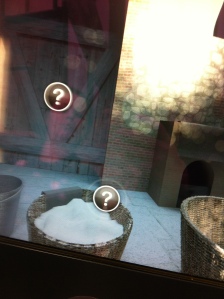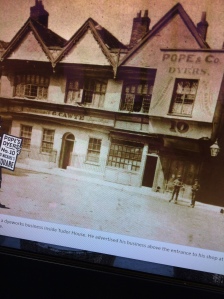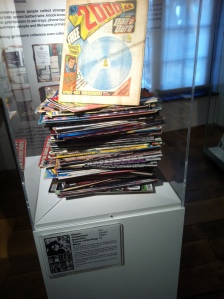Southampton Tudor House (and more RTI)
I can’t read for a PhD in digital technology and cultural heritage interpretation at Southampton and not visit the recently reopened Tudor House Museum, which touts some of the very latest interpretation technology. So with my daughter on an inset day from school, I thought this would be the ideal opportunity for an educational visit.
We parked at the West Quay shopping centre, and skipped across the road to Bugle Street (what a great name). A very reasonable price for entry, even though I only got 10% for my MA membership. We took the audio tour wands and started with the AV presentation in the banqueting hall. Lily said later that this was her favourite bit, and I can see why: the room it atmospherically lit with wobbly-wick candle and a “crackling fire” in the hearth. Then, over the spitting of the logs, we hear whispers. Somewhere, somewhere close, people are shushing each-other, then talking, about us. Fairy-trails sparkles across the walls and curtains, and all of a sudden, the fire and candles are blown out. My daughter, almost twelve, was impressively spooked, especially by the rat she heard in the dark, scuttling under the bench.
And the Timeweaver introduces himself, and the spirits of the house, as friends and guides. They give us give us a short tape/slide presentation, a potted history of the house and its early 20th century “restoration,” being careful to point out the features in this room, for example, the musicians gallery, which are inventions of that restoration. Then the spirits are banished, the great curtain thrown open and the room is bathed in daylight. We are invited to explore the house, audio wands in hand.
The audio guides direct us to the garden first, to see the remains of “King John’s palace” (which turns out to have nothing to do with King John) and to admire the the Tudor style garden, before heading back into the domestic service areas of the house. Its worth pointing out here that the audio guide has a jarring change of tone here. An authoritive female voice guides us round the garden, presenting us with “facts,” but when we return to the house the Timeweaver greets us again and with the help of his spirits revealed the house with more of a storyteller’s style. I thought my audio tour had switched to the children’s commentry, but my daughter said the authoritative woman was her guide round the gardens too.
Inside the house we also met the museum’s “state of the the art technology” GuidA Rotate units from Blackbox-av. These touch-screen panels gave us computer generated models of the room in which they were sited at various points in history. Their USP being that they can be rotated around the room, so you always have both the relevant bit of the real world and the computer simulation in front of you. What struck me first were the differences between the “now” model, and the reality in front of me.
In every era the model also features “hot spots” which you can touch for a layer of extra interpretation. Sometimes this is directly related to the feature you are looking at, but sometimes the interpretation seemed more generic. Touch a barrel of … what? … salt? for example, and you get a photo the fascade when the house was occupied by dyers, but you still don’t know what was in the barrel.
A nice touch in the the first room is a screen mounted on the wall above the GuidA Rotate, so others in the room can see what the person controlling the device is looking at. And I loved the inclusion of a model of how the room might have looked in the late twentieth century, when it was a museum education room. It means something special when education sessions become part of the historic record.
Later on there’s another GuidA Rotate in a lavish bedroom, showing how the room might have looked in the Tudor, Georgian and Victorian periods. But the same model also features on the one of the lenticular panels which are also a feature of the interpretation.
![IMG_3627[1]](http://memetechnology.files.wordpress.com/2013/02/img_36271.jpg?w=112&h=150)
![IMG_3628[1]](http://memetechnology.files.wordpress.com/2013/02/img_36281.jpg?w=112&h=150)
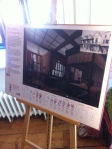
This clever use of an old technology amused me more than the (I’m guessing more expensive and less reliable) GuidA Rotate units.
But what amused me the most was the temporary exhibition, which did something I’ve always wanted to do – challenge the values of museum collecting, with the more personal (and more modern) collections of local people. And what I especially wanted to do happens here: a comics collection is featured!
When we passed a wall in which faint graffiti had been scratched I tried to tell my daughter about the day I spent at Winchester using RTI photgraphy to make clearer imaged of similar graffiti. She wasn’t that interested, but on the other side of the wall are interactive units that allow visitors to look at clearer images of the graffiti – I bet my university colleagues (and their string and shiny balls) have already been involved …
Talking of which, I got an email today with a link to some of the images we created on that day. So I’ll update my post to include it.

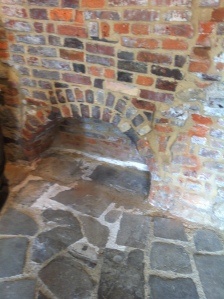
![... and the virtual one. IMG_3613[1]](http://memetechnology.files.wordpress.com/2013/02/img_36131.jpg?w=224&h=300)
